 When talking about virtualization, we spend most of our coverage on the enterprise application and infrastructure sides of the business. However, the end-user content we produce does very well also; there's a growing interest in the enterprise when it comes to enabling users to take advantage of maturing technologies to deliver a PC-like experience via thin client. The reasons are varied, but the motivation largely comes down to enabling a global workforce with a secure, yet high-performance workspace. In fact, we recently explored these issues with Luke Wignall from NVIDIA in a podcast. So that we may appropriately cover the high-end VDI space, what we prefer to call virtual workstations, StorageReview has been working with a set of partners to build out a dedicated test environment in our lab. HPE, HP, NVIDIA, ESRI, VMware and others have all contributed so that we may take both a holistic look at virtual workstation infrastructures, while still drilling down into the individual components to understand their impact on performance.
When talking about virtualization, we spend most of our coverage on the enterprise application and infrastructure sides of the business. However, the end-user content we produce does very well also; there's a growing interest in the enterprise when it comes to enabling users to take advantage of maturing technologies to deliver a PC-like experience via thin client. The reasons are varied, but the motivation largely comes down to enabling a global workforce with a secure, yet high-performance workspace. In fact, we recently explored these issues with Luke Wignall from NVIDIA in a podcast. So that we may appropriately cover the high-end VDI space, what we prefer to call virtual workstations, StorageReview has been working with a set of partners to build out a dedicated test environment in our lab. HPE, HP, NVIDIA, ESRI, VMware and others have all contributed so that we may take both a holistic look at virtual workstation infrastructures, while still drilling down into the individual components to understand their impact on performance.
When talking about virtualization, we spend most of our coverage on the enterprise application and infrastructure sides of the business. However, the end-user content we produce does very well also; there's a growing interest in the enterprise when it comes to enabling users to take advantage of maturing technologies to deliver a PC-like experience via thin client. The reasons are varied, but the motivation largely comes down to enabling a global workforce with a secure, yet high-performance workspace. In fact, we recently explored these issues with Luke Wignall from NVIDIA in a podcast. So that we may appropriately cover the high-end VDI space, what we prefer to call virtual workstations, StorageReview has been working with a set of partners to build out a dedicated test environment in our lab. HPE, HP, NVIDIA, ESRI, VMware and others have all contributed so that we may take both a holistic look at virtual workstation infrastructures, while still drilling down into the individual components to understand their impact on performance.
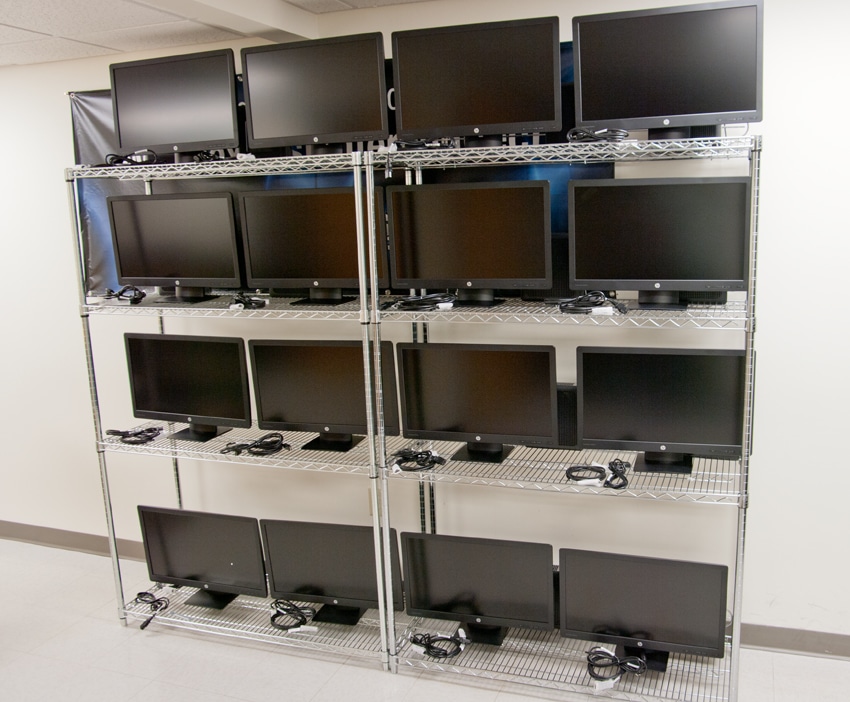
Currently the test environment is based on an HPE server with twin NVIDIA GPUs inside. To ensure we have a qualitative measure of performance in addition to hard numbers, we set up sixteen thin client stations to tax the infrastructure. This allows us to pull performance at the thin client level via software like ESRI, while maintaining a watchful eye over the aggregate performance of all sixteen virtual workstations. The intent is to expand into other end user applications and provide insight as to the effect of hardware and software on the virtual workstation environment.
HP Thin Clients
The HP t730 is touted as the company’s most powerful desktop thin client. This business-grade solution is built to handle demanding, resource-intensive environments by leveraging the latest generation of AMD’s quad-core APU with Turbo Core technology. To promote scalability, HP has equipped the t730 with serial, parallel, PS/2, and USB ports and a PCI Express x8 low profile expansion slot. The t730 is seamless to deploy, easy to manage, and ready to use right out of the box.
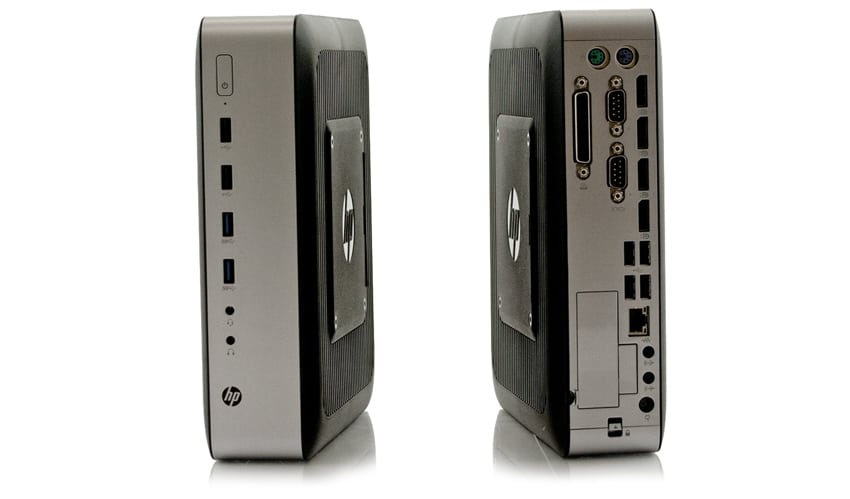
The HP t730 features a Radeon HD 9000 graphics card (standard), up to 128GB of MLC flash memory, and 16GB of DDR3L-1600 SDRAM. For those looking for more power in their GPU, uses have the option of equipping the t730 with the AMD FirePro W2100 professional graphics card. This workhorse GPU features the AMD GCN architecture and is designed to for both GPU compute and 3D workloads. The t730 also features DisplayPort connections, which allow up to four UHD/4K2 monitors (six when using the FirePro W2100) for a ton of potential display real estate as well as a generous maximum native resolution of 3840 x 2160.
HP t730 Thin Client Specifications
- Operating System:
- Windows 10 IoT Enterprise for Thin Clients
- Windows Embedded Standard 7P
- HP ThinPro
- HP Smart Zero Core
- Core Processing Technology: AMD RX-427BB APU with Radeon HD 9000 graphics (2.7 GHz up to 3.6 GHz, 4 MB cache, 4 cores)
- Storage:
- up to 128 GB MLC flash memory
- up to 32 GB UMLC flash memory
- Graphics:
- AMD Radeon GPU; AMD FirePro W2100
- (AMD Radeon GPU integrated as part of the R-Series APU)
- System Memory: 16 GB DDR3L-1600 SDRAM (Transfer rates up to 1600 MT/s)
- Memory Slots: 2 SODIMM
- Networking: Realtek GbE; Intel 802.11a/b/g/n/ac PCIe; Broadcom 802.11a/b/g/n PCIe; Allied Telesis AT-27M2/SC M.2 Fiber Fast Ethernet Network Interface;
- Allied Telesis AT-29M2/SC M.2 Gigabit Ethernet Network Interface
- Audio: Internal amplified speaker system for basic audio playback
- Display Support: Four DisplayPort 1.2 digital video outputs supporting up to 3840 x 2160 resolution. An optional AMD FirePro W2100 discrete graphics solution provides two additional digital video streams for a system total of six video outputs.
- Input Devices:
- HP Keyboard
- HP Mouse
- Power: 85 W, 100-240 VAC
- Energy Efficiency Compliance ENERGY STAR certified and EPEAT Gold registered configurations available 5
- Input/Output
- Front: 2 USB 3.0; 2 USB 2.0; 1 headset; 1 headphone/microphone
- Back: 4 USB 2.0; 4 DisplayPort 1.2; 2 PS/2; 2 serial; 1 parallel; 1 audio line in; 1 audio line out
- Inside chassis: 1 USB 3.0
- Dimensions (W x D x H): 8.7 x 2.6 x 9.4 in
- Weight: 2.29 lb starting
- Software: HP Device Manager; HP ThinUpdate; HP Easy Tools; HP Smart Zero Client Services; Microsoft SCCM/EDM Agent; HP Velocity; HP Easy Shell; HP True Graphics
- Protocols:
- Microsoft RFX/RDP; Citrix ICA/HDX; VMware Horizon RDP/PCoIP
AMD FirePro W2100 Specifications
- Memory:
- 2GB DDR3 memory
- Compute Performance:
- 320 stream processors (5 compute units)
- Display Outputs:
- Two Standard DisplayPort 1.2a outputs
- Maximum DisplayPort 1.2a resolution 4096×2160
- Maximum DisplayPort 1.1 resolution 2560×1600
- API & OS Support:
- DirectX 11.2 / 12
- OpenGL 4.43
- OpenCL 1.2
- AMD Mantle
- Shader Model: 5.0
- Microsoft Windows 10, Windows® 8.1 and Windows® 7 (32- or 64-bit)
- Linux (32- or 64-bit)
- Cooling/Power/Form Factor
- <26W maximum power consumption
- Discreet active cooling solution
- Half height/half-length single-slot form factor
- PCIe 3.0 compliant, x8
Attached to each t730 workstation is a HP ProDisplay P240va, a 24-inch monitor that is meant for everyday business use. Featuring a native 1920 x 1080 resolution and a 78-degree viewing angle, the P240va is equipped with a VGA and HDM1 port as well as one HDCP-compatible DisplayPort 1.2. The monitor is also bundled with an adjustable display stand, integrated power supply, and effective cable management to help reduce its physical footprint.
HPE ProLiant DL380 Gen9 Server
We will be running the sixteen thin clients through an HPE ProLiant DL380 Gen9 rack-mount server. The DL380 Gen9 server a versatile solution designed for virtually any mainstream workload and features Intel’s latest E5-2600 v4 processors.
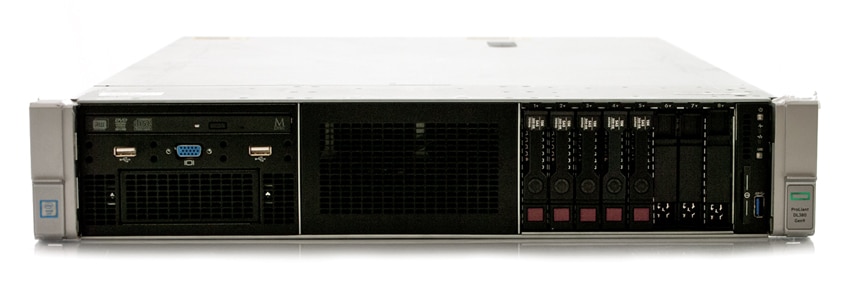
The HPE ProLiant DL380 Gen 9 offers the ability to have up to 24 small for factor (SFF) bays or 12 large form factor bays (LFF), for our review ours is configured with 8 SFF bays for 2.5" drives. Along with these options the DL380 also offers NVMe support and even more drive support in the rear, for companies that may continue to expand in the future. The DL380 supports up to 3TB of memory (HPE 2400MHZ DDR4 SmartMemory specifically), our build has 128GB. For networking, the DL380 offers customers the choice of embedded 4x1GbE, optional HPE FlexibleLOM or PCIe standup 1GbE to 40GbE Adapters depending on their needs. For our use case we are using the embedded 1Gb 4-port 331i Adapter and 10Gb 2-port 533FLR-T Adapter.
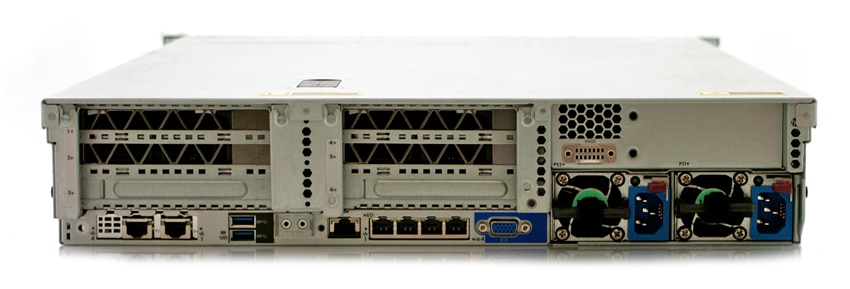
HPE ProLiant DL380 Gen9 Specifications
- 2 x Intel Xeon E5-2650 v3 (2.3GHz, 10 cores)
- 16 x 8GB DDR4 Memory
- Smart Array P440ar Controller
- 5 x 300GB 15K HDD in RAID6
- 2 x NVIDIA Tesla M60 GPU
- 16GB GDDR5
- HPE Ethernet 1Gb 4-port 331i Adapter
- HPE FlexFabric 10Gb 2-port 533FLR-T Adapter
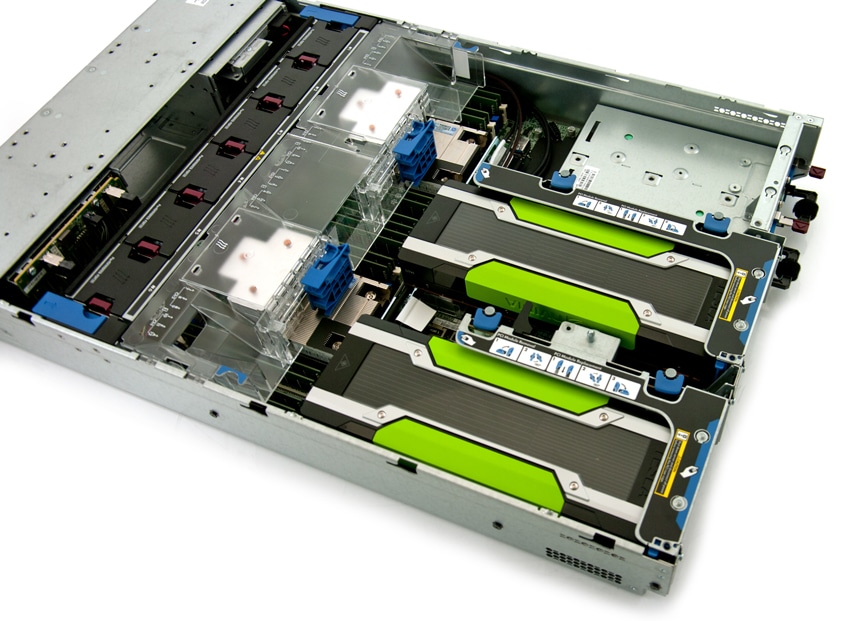
NVIDIA Tesla M60
The NVIDIA Tesla M60 is a GPU accelerator that works with NVIDIA’s GRID software. The M60 is designed specifically delivering high performance for virtualized workstations. The M60 is stated as being able to deliver end user experience over VDI that appears as though the user is sitting in front of a high-end workstation. The Tesla M60 can support up to 32 users per board and has a whopping 4,096 NVIDIA CUDA cores.
NVIDIA Tesla M60 Specifications
- Form Factor: PCIe 3.0 Dual Slot
- Number of GPUs: Dual High-End Maxwell
- Total NVIDIA CUDA Cores: 2,048/GPU (4,096 total)
- Memory: 8GB/GPU (16GB GDDR5 total)
- Max vGPU instances: 32
- Power: 240W/300W (225W optional)
- Cooling: Active/Passive
- Dimensions: 10.5” x 4.4”
Ultimately we intend to leverage this fantastic mix of partners to deliver industry-leading testing of virtual workstation environments. As can be seen here, the VDI lab is well on its way to delivering on that goal with an initial implementation of ESRI across the 16 virtual workstations. Certainly much more is to come however as we explore the impact of hardware and software on this high-end VDI configuration.
Sign up for the StorageReview newsletter
